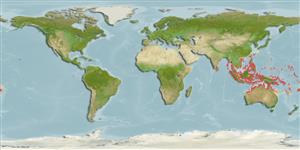Environment: milieu / climate zone / depth range / distribution range
นิเวศวิทยา
เกี่ยวกับทะเล,น้ำเค็ม; กร่อย เกี่ยวกับหินโสโครก; ระดับความลึก 0 - 20 m (Ref. 48637), usually 0 - 15 m (Ref. 90102). Tropical; 19°C - 38°C (Ref. 1827); 30°N - 30°S, 77°E - 20°W
Indo-West Pacific: India, Sri Lanka, Andaman Islands, Thailand, Malaysia, Singapore, Indonesia, Philippines, Belau [=Palau], Guam, New Guinea, Solomon Islands, Fiji, Vanuatu, ?New Caledonia, ?Western Australia, ?Pohnpei, Caroline Islands, ?Ebon Island and Marshall Islands.
ขนาด / น้ำหนัก / Age
Maturity: Lm ? range ? - ? cm
Max length : 45.0 cm TL เพศผู้/กระเทย; (Ref. 1419); common length : 30.0 cm TL เพศผู้/กระเทย; (Ref. 9813); น้ำหนักสูงสุดที่มีการรายงาน: 2.4 kg (Ref. 125599)
เงี่ยงครีบหลัง (รวม) : 13; ก้านครีบอ่อนที่หาง (รวม) : 10; เงี่ยงครีบก้น: 7; ก้านครีบอ่อนที่ก้น: 9; สัตว์มีกระดูกสันหลัง: 13. Body bluish white; head brown to brownish or golden yellow with irregular blue lines. Preopercular angle 91°-102°; strong overlapping scales cover cheeks; midline of thorax scaled, not pelvic ridges. Anterior nostril with low flange, broadened slightly posteriorly. Spines stout, blunt or pungent, and venomous.
Juveniles live among mangroves then move out to lagoon and coastal reefs as they mature. Forms schools. Feeds on algae growing on seagrasses, mangrove roots and rocks. Adults congregate inshore in groups of several hundreds to spawn in summer. Spawning is by pairs; sticky eggs laid on the bottom. Its very high quality flesh commands premium prices (Ref. 9813). Adults on coastal reefs, subject to strong currents (Ref. 48637). This species can tolerate very low salinities (2 ppt) and temperatures up to 38 C (Ref. 37816).
Throughout summer, adults form inshore breeding groups of several hundred individuals on the 7th or 8th days of the lunar month; pairs break from these groups to spawn. The species has a high fecundity of 350,000/spawning season.
Woodland, D.J., 1990. Revision of the fish family Siganidae with descriptions of two new species and comments on distribution and biology. Indo-Pac. Fish. (19):136 p. (Ref. 1419)
IUCN Red List Status (Ref. 130435)
Human uses
การประมง: การค้า; การเพาะเลี้ยงสัตว์น้ำ: การใช้ที่น่าจะเกิดในอนาคต; สถานที่แสดงสัตว์และพืชน้ำ: การค้า
เครื่องมือ
Special reports
Download XML
แหล่งที่มาจากอินเตอร์เน็ต
Estimates based on models
Preferred temperature (Ref.
123201): 26.2 - 29.3, mean 28.6 °C (based on 2941 cells).
Phylogenetic diversity index (Ref.
82804): PD
50 = 0.5000 [Uniqueness, from 0.5 = low to 2.0 = high].
Bayesian length-weight: a=0.01230 (0.00669 - 0.02263), b=3.13 (2.97 - 3.29), in cm total length, based on LWR estimates for this species & Genus-body shape (Ref.
93245).
ระดับชั้นอาหาร (Ref.
69278): 2.0 ±0.00 se; based on food items.
ความสามารถในการกลับคืนสู่ปกติ (Ref.
120179): ขนาดกลาง, เวลาต่ำสุดที่จะทำให้ประชากรเพิ่มขึ้นเป็น 2 เท่าใช้เวลา 1.4 - 4.4 ปี (K=0.3).
Fishing Vulnerability (Ref.
59153): Low vulnerability (20 of 100).
Nutrients (Ref.
124155): Calcium = 44.8 [22.4, 129.2] mg/100g; Iron = 0.979 [0.445, 2.429] mg/100g; Protein = 19 [17, 21] %; Omega3 = 0.0994 [, ] g/100g; Selenium = 35.2 [11.4, 95.8] μg/100g; VitaminA = 10.3 [2.0, 55.5] μg/100g; Zinc = 1.82 [0.68, 4.15] mg/100g (wet weight);
